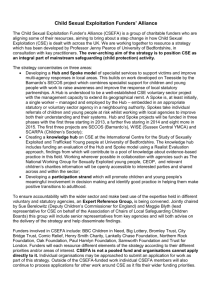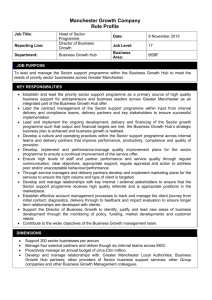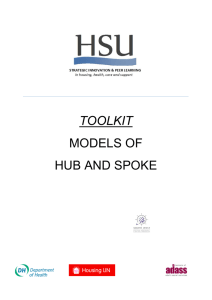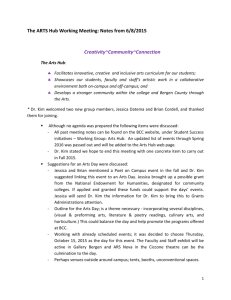CSEFA Hub & Spoke leaflet
advertisement
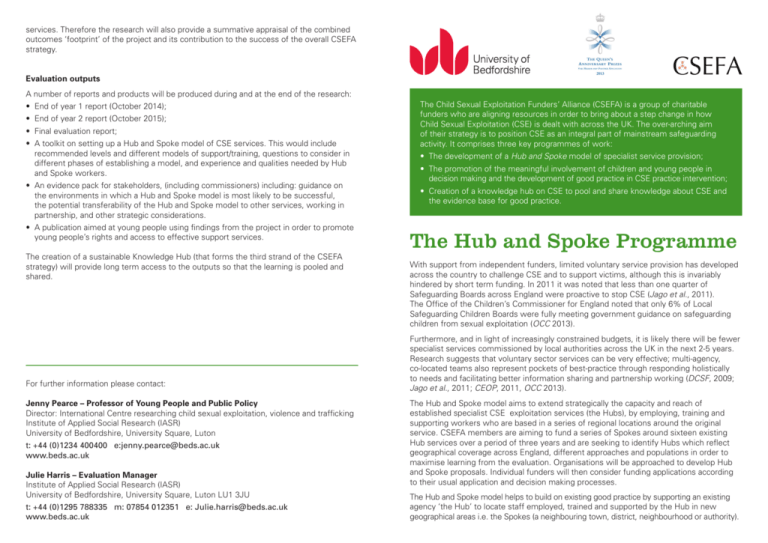
services. Therefore the research will also provide a summative appraisal of the combined outcomes ‘footprint’ of the project and its contribution to the success of the overall CSEFA strategy. Evaluation outputs A number of reports and products will be produced during and at the end of the research: • End of year 1 report (October 2014); • End of year 2 report (October 2015); • Final evaluation report; • A toolkit on setting up a Hub and Spoke model of CSE services. This would include recommended levels and different models of support/training, questions to consider in different phases of establishing a model, and experience and qualities needed by Hub and Spoke workers. • A n evidence pack for stakeholders, (including commissioners) including: guidance on the environments in which a Hub and Spoke model is most likely to be successful, the potential transferability of the Hub and Spoke model to other services, working in partnership, and other strategic considerations. • A publication aimed at young people using findings from the project in order to promote young people’s rights and access to effective support services. The creation of a sustainable Knowledge Hub (that forms the third strand of the CSEFA strategy) will provide long term access to the outputs so that the learning is pooled and shared. For further information please contact: Jenny Pearce – Professor of Young People and Public Policy Director: International Centre researching child sexual exploitation, violence and trafficking Institute of Applied Social Research (IASR) University of Bedfordshire, University Square, Luton t: +44 (0)1234 400400 e:jenny.pearce@beds.ac.uk www.beds.ac.uk Julie Harris – Evaluation Manager Institute of Applied Social Research (IASR) University of Bedfordshire, University Square, Luton LU1 3JU t: +44 (0)1295 788335 m: 07854 012351 e: Julie.harris@beds.ac.uk www.beds.ac.uk The Child Sexual Exploitation Funders’ Alliance (CSEFA) is a group of charitable funders who are aligning resources in order to bring about a step change in how Child Sexual Exploitation (CSE) is dealt with across the UK. The over-arching aim of their strategy is to position CSE as an integral part of mainstream safeguarding activity. It comprises three key programmes of work: • The development of a Hub and Spoke model of specialist service provision; • T he promotion of the meaningful involvement of children and young people in decision making and the development of good practice in CSE practice intervention; • C reation of a knowledge hub on CSE to pool and share knowledge about CSE and the evidence base for good practice. The Hub and Spoke Programme With support from independent funders, limited voluntary service provision has developed across the country to challenge CSE and to support victims, although this is invariably hindered by short term funding. In 2011 it was noted that less than one quarter of Safeguarding Boards across England were proactive to stop CSE (Jago et al., 2011). The Office of the Children’s Commissioner for England noted that only 6% of Local Safeguarding Children Boards were fully meeting government guidance on safeguarding children from sexual exploitation (OCC 2013). Furthermore, and in light of increasingly constrained budgets, it is likely there will be fewer specialist services commissioned by local authorities across the UK in the next 2-5 years. Research suggests that voluntary sector services can be very effective; multi-agency, co-located teams also represent pockets of best-practice through responding holistically to needs and facilitating better information sharing and partnership working (DCSF, 2009; Jago et al., 2011; CEOP, 2011, OCC 2013). The Hub and Spoke model aims to extend strategically the capacity and reach of established specialist CSE exploitation services (the Hubs), by employing, training and supporting workers who are based in a series of regional locations around the original service. CSEFA members are aiming to fund a series of Spokes around sixteen existing Hub services over a period of three years and are seeking to identify Hubs which reflect geographical coverage across England, different approaches and populations in order to maximise learning from the evaluation. Organisations will be approached to develop Hub and Spoke proposals. Individual funders will then consider funding applications according to their usual application and decision making processes. The Hub and Spoke model helps to build on existing good practice by supporting an existing agency ‘the Hub’ to locate staff employed, trained and supported by the Hub in new geographical areas i.e. the Spokes (a neighbouring town, district, neighbourhood or authority). The Hub could be a voluntary agency or a voluntary-statutory partnership. Ideally, it would be a multi-agency team bringing expertise of working with CSE together from different professionals. The Hub would be the central location through which staff support, training and supervision takes place. It would be flexible in service delivery; being able to fundraise to meet new demands and adaptable to meet the changing needs of children and young people. It is anticipated that Hub services will work with young women or young men at risk of CSE (or both) including those experiencing different forms of discrimination and could run a range of different programmes and interventions to meet local needs. The Hub and Spoke model is not prescriptive about the structure or composition of the Hub or of the nature of the work it undertakes. However all Hubs will agree to work according to a set of principles (see below). The evaluation will specifically address the following research questions: Supported by the Hubs, the Spoke staff will: 1 Develop strategic influence at local level; 2 Increase the awareness of CSE and its signs amongst key agencies and practitioners; 3 Provide direct support to young people affected by CSE and advice to other professionals working with them. 5 H ow successful is the Hub and Spoke model in improving key outcomes for young people at risk of or affected by CSE? Timescales for the Development Programme The Research Team The Hub and Spoke strategy will develop over a three year period as follows: Phase 1: Three services from October 2013; Phase 2: Five services from October 2014; Phase 3: Eight services from October 2015. The ‘International Centre: Researching child sexual exploitation, violence and trafficking’ is based at the University of Bedfordshire and is led by Professor Jenny Pearce. As the UK’s leading centre of research into child sexual exploitation, staff have extensive experience of producing research with young people who are often marginalised from mainstream services through their experiences or vulnerabilities. The research will be managed and undertaken by a team of experienced evaluators, combining an expertise of child sexual exploitation and young people’s participation with a rigorous research methodology. The Evaluation – Aims and Scope Although there is growing evidence about what effective support for young people affected by CSE looks like, there is little comparative evaluation of CSE services since Barnardo’s evaluation of ten services (Scott and Skidmore, 2006) and no evaluation between different providers or models of service delivery. The evaluation will follow the progress of the sixteen Hub and Spoke services as they develop over the next three years, including the methods and models of engaging children and young people as participants in service development and delivery. The overall aim of the evaluation is to provide knowledge about the potential of this model to trigger cultural and systemic change in the way that children’s services respond to child sexual exploitation. Existing Hub services may already have in place a variety of approaches to monitoring and evaluating individual service effectiveness and the intention of this evaluation is not to replicate or duplicate these processes. Rather the evaluation will focus on the development of the ‘Hub and Spoke’ approach and the changes that come about at local level through its implementation. Specifically, we would expect the evaluation to consider the impact of the model on: a) Safeguarding young people from sexual exploitation through service delivery; b) E ngaging young people as active participants in development and delivery of services that impact on them; c) Supporting and equipping Spoke workers to work effectively in host agencies; d) P romoting stable CSE policy frameworks in new areas by raising awareness, developing procedures and advancing cultures of support from policy makers responsible for CSE. 1 H ow effective is the Hub and Spoke model in promoting effective CSE policy frameworks and the development of effective procedures and protocols that support cross agency responses? 2 W hat is the impact of the model on increasing the awareness, identification and response to CSE amongst key agencies working with children and young people? 3 W hat local conditions and arrangements determine and best support the development of sustainable and effective Spoke services? 4 H ow effectively can Hub services support Spoke staff in working within host agencies and over geographical distance? The evaluation will include an assessment of young people’s participation in each of the five research questions identified above. 2.1 Methodology The research team will use a realist approach to the evaluation. This is a robust framework that takes into account the contexts that will either inhibit or support service delivery; the behavioural mechanisms that are triggered in these contexts; and the outcomes that are produced (Pawson and Tilley, 1997), as follows: a) O utcomes achieved for young people. These are likely to include quantitative data on indicators of risk of sexual exploitation (missing incidents, engagement with education, drug and alcohol use), as well as qualitative data from interviews and focus groups, identifying if and why young people value the service. b) M echanisms that produced these outcomes. Service outputs will be monitored (number of young people referred and worked with, training sessions delivered etc), alongside interviews that explore the key ways that change and influence is produced. c) Contexts that enabled or inhibited effective working. Through interviews and local statistics, the evaluation team will pay attention to the key aspects of each local context that affect the way a Hub and Spoke model works. Realist evaluation asks ‘what works for whom, in what circumstances, and why?’ As such it will allow us to make recommendations about the local contexts in which a Hub and Spoke model is most and least likely to be effective. This will be a formative evaluation, feeding findings into the ongoing development and delivery of the Hub and Spoke strategy including the principles of best practice for all Hub and Spoke models. However, the intention is also to gather evaluation data on project outcomes over the full sixteen
